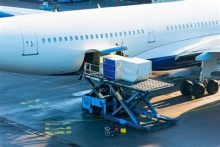 Air cargo demand fell for the fifth month in a row in July as the industry continues to face a ‘multitude of disruptions’, according to CLIVE Data Services. The Xeneta-owned data provider said that during July air cargo demand dropped by 9% year on year and the dynamic load factor – taking into account both weight and space – slipped 8 percentage points on last year to 58%.In July rates were up 11% on a year ago – and 121% of July 2019 – but CLIVE pointed out that the gap between pre-covid levels has continued to narrow. Xeneta chief airfreight officer Niall van de Wouw said that the demand declines come as the industry is hit by a multitude of disruptions outside of its control, such as the war in Ukraine and the cost of living crisis which is increasingly affecting household budgets. Meanwhile, airlines and airports continue to suffer “severe operational challenges due to significant shortages of ground staff.”“There are many dark clouds hanging over the air cargo industry given the state of the world right now,” said van de Wouw. “Volumes are subdued, and while air cargo rates are still elevated, they are slowly but surely easing back towards pre-Covid levels. From a rates point of view, indicators suggest the market has yet to bottom out. It’s clear that airlines are following the market very closely to ensure they are deploying their assets in the best possible way because the market is moving quickly. We have already seen freighters moving away from transatlantic routes. On the Atlantic, the decline in general airfreight rates we reported for the previous three months of 2022 continued in July,” he added. “While this will be partly seasonal, the slight increase in load factor across the Atlantic relative to June – from 58% to 61% – might be a result of carriers and forwarders redirecting their freighter operations to other lanes, hence pushing up the load factor for the remaining flights on these routes,” he said.
Air cargo demand fell for the fifth month in a row in July as the industry continues to face a ‘multitude of disruptions’, according to CLIVE Data Services. The Xeneta-owned data provider said that during July air cargo demand dropped by 9% year on year and the dynamic load factor – taking into account both weight and space – slipped 8 percentage points on last year to 58%.In July rates were up 11% on a year ago – and 121% of July 2019 – but CLIVE pointed out that the gap between pre-covid levels has continued to narrow. Xeneta chief airfreight officer Niall van de Wouw said that the demand declines come as the industry is hit by a multitude of disruptions outside of its control, such as the war in Ukraine and the cost of living crisis which is increasingly affecting household budgets. Meanwhile, airlines and airports continue to suffer “severe operational challenges due to significant shortages of ground staff.”“There are many dark clouds hanging over the air cargo industry given the state of the world right now,” said van de Wouw. “Volumes are subdued, and while air cargo rates are still elevated, they are slowly but surely easing back towards pre-Covid levels. From a rates point of view, indicators suggest the market has yet to bottom out. It’s clear that airlines are following the market very closely to ensure they are deploying their assets in the best possible way because the market is moving quickly. We have already seen freighters moving away from transatlantic routes. On the Atlantic, the decline in general airfreight rates we reported for the previous three months of 2022 continued in July,” he added. “While this will be partly seasonal, the slight increase in load factor across the Atlantic relative to June – from 58% to 61% – might be a result of carriers and forwarders redirecting their freighter operations to other lanes, hence pushing up the load factor for the remaining flights on these routes,” he said.
Breaking News
- INDIARPORT to focus on improving infra, skills & sustainability
- Rhenus expands airfreight capabilities in Southeast Asia
- Beyond Sqfeet honoured with the Excellence in Contract Logistics Award @ICA
- ‘Build strong relations with authorities & train staff to boost efficiency’
- ‘ACAAI needs to reinvent itself to stay relevant’
- ‘Discussions offered practical direction for turning constraints into growth’
- ‘ACAAI is all about innovation, knowledge & collaboration’
- ‘True value lies in implementation of topics discussed at ACAAI’
- ‘The concept of co-loading bonded cargo in a single truck is my key takeaway from ACAAI’
- ‘The associations must engage with govt for prospective solutions’
- ‘The event offers opportunity to confabulate with a cross section of the cargo trade fraternity’
 Cargo Breaking News
Cargo Breaking News


